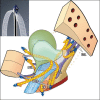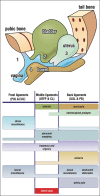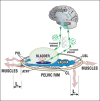Is overactive bladder in the female surgically curable by ligament repair?
- PMID: 28461989
- PMCID: PMC5407336
- DOI: 10.5173/ceju.2017.938
Is overactive bladder in the female surgically curable by ligament repair?
Abstract
Introduction: Overactive bladder (OAB) symptoms (urge, frequency, nocturia) are not generally considered surgically curable by learning institutions. The Integral Theory hypothesizes that OAB is a prematurely activated, but normal micturition reflex caused by loose suspensory ligaments and potentially curable surgically by repairing such ligaments. To test this hypothesis by surgical repair of loose cardinal and uterosacral ligaments in patients with 2nd degree or greater uterine/apical prolapse.
Material and methods: Multicenter prospective case control audit. 611 females, mean age 70. Inclusions: symptomatic apical prolapse of 2nd or greater degree, (POPQ stages 2-4), and at least two pelvic symptoms. Exclusions: Comorbid medical problems known to cause chronic pelvic pain (e.g., infection), sphincter tears, neurological bladder conditions. Surgery: minimally invasive cardinal/uterosacral ligament repair using the TFS (Tissue Fixation System). Primary outcome: Uterine prolapse cure; Secondary outcomes; bladder, bowel, and pain symptoms improvement.
Results: 90% prolapse cure in 611 patients. Symptom incidence (% Cure at 12 months in brackets) was: urge incontinence: n = 310 (85%); frequency: n = 317 (83%); nocturia: n = 254 (68%); chronic pelvic pain (CPP): n = 194 (77%); fecal incontinence: n = 93 (65%). Statistics: McNemar x2-tests to test for significant changes in the symptoms' incidence-frequency from baseline (preoperative) to the postoperative phase. For each symptom the null hypothesis H0: P(baseline) = P(12 months after surgery)versus H1: P(baseline) ≠ P(12 months after surgery) was tested, with P indicating prevalence or incidence rate.
Conclusions: Bladder & bowel incontinence and chronic pelvic pain occur in predictable groupings and are associated with apical prolapse. OAB symptom improvement with the TFS ligament repair provides a good alternative to anticholinergics, especially when considering their association with dementia causation. Application of the Integral Theory System has the potential to significantly improve clinical practice, QoL for ageing women, delaying entry into Nursing Homes and creating new scientific research directions. The take home message is that symptoms of chronic pelvic pain, bladder and bowel dysfunction occur in relatively predictable groups, caused by lax suspensory ligaments and can be cured or improved by TFS mini sling ligament repair.
Keywords: Integral Theory; Over active bladder; TFS; apical prolapse; chronic pelvic pain; fecal incontinence; nocturia; urge incontinence.
Conflict of interest statement
The authors declare no conflicts of interest.
Figures





References
-
- Abrams P, Cardozo L, Fall M, et al. The standardisation of terminology of lower urinary tract function: report from the Standardisation Sub-committee of the International Continence Society. Neurourol Urodyn. 2002;21:167–178. - PubMed
-
- Andersson K-A, Chapple C, Cardozo L, et al. In: Pharmacological Treatment of Urinary Incontinence in Incontinence 5th International Consultation Paris Feb. Abrams P, Cardozo L, Khoury S, Wein A, editors. 2012. pp. 623–728. ISBN 978-9953-493-21-3.
-
- Petros PE, Ulmsten U. An Integral Theory of female urinary incontinence. Acta Obstet Gynecol Scand Suppl. 1990;69(153):1–79. - PubMed
-
- Petros P, Ulmsten U. Is detrusor instability a prematurely activated (but otherwise normal) micturition reflex? Lancet. 1997;349:505. - PubMed
-
- Petros PE, Ulmsten U. Bladder instability in women: A premature activation of the micturition reflex. Neurourol Urodyn. 1993;12:235–239. - PubMed
LinkOut - more resources
Full Text Sources
Miscellaneous
